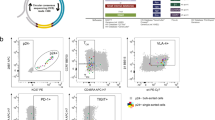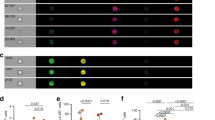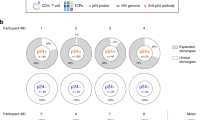Abstract
Although it is presumed that the integration of HIV-1 into the genome of infected CD4+ T lymphocytes allows viral persistence, there has been little direct evidence that CD4+ T cells with integrated provirus function as a latent reservoir for HIV-1 in infected individuals. Using resting CD4+ T-cell populations of extremely high purity and a novel assay that selectively and unambiguously detects integrated HIV-1, we show that resting CD4+ T cells harbouring integrated provirus are present in some infected individuals. However, these cells do not accumulate within the circulating pool of resting CD4+ T cells in the early stages of HIV-1 infection and do not accumulate even after prolonged periods in long-term survivors of HIV-1 infection. These results suggest that because of viral cytopathic effects and/or host effector mechanisms, productively infected CD4+ T cells do not generally survive for long enough to revert to a resting memory state in vivo.
This is a preview of subscription content, access via your institution
Access options
Subscribe to this journal
Receive 12 print issues and online access
$209.00 per year
only $17.42 per issue
Buy this article
- Purchase on Springer Link
- Instant access to full article PDF
Prices may be subject to local taxes which are calculated during checkout
Similar content being viewed by others
References
Yasutomi, Y., Reimann, K.A., Lord, C.I., Miller, M.D. & Letvin, N.L. Simian immunodeficiency virus-specific CD8+ lymphocyte response in acutely infected rhesus monkeys. J. Virol. 67, 1707–1711 (1993).
Koup, R.A. et al. Temporal association of cellular immune responses with the initial control of viremia in primary human immunodeficiency virus type 1 syndrome. J. Virol. 68, 4650–4655 (1994).
Borrow, P., Lewicki, H., Hahn, B.H., Shaw, G.M. & Oldstone, M.B. Virus-specific CD8+ cytotoxic T-lymphocyte activity associated with control of viremia in primary human immunodeficiency virus type 1 infection. J. Virol. 68, 6103–6110 (1994).
Pantaleo, G. et al. Major expansion of CD8+ T cs with a predominant Vβ usage during the primary immune response to HIV. Nature 370, 463–467 (1994).
Harper, M.E., Marselle, L.M., Gallo, R.C. & Wong-Staal, F. Detection of lymphocytes expressing human T-lymphotropic virus type III in lymph nodes and peripheral blood from infected individuals by in situ hybridization. Proc. natn. Acad. Sci. U.S.A. 83, 772–776 (1986).
Ho, D.D., Moudgil, T. & Alam, M. Quantitation of human immunodeficiency virus type 1 in the blood of infected persons. New Engl. J. Med. 321, 1621–1625 (1989).
Schnittman, S.M. et al. The reservoir for HIV-1 in human peripheral blood is a T cell that maintains expression of CD4. Science 245, 305–308 (1989).
Psallidopoulus, M.C. et al. Intergrated proviral human immunodeficiency virus type 1 is present in CD4+ peripheral blood lymphocytes in healthy seropositive individuals. J. Virol. 63, 4626–4631 (1989).
Simmonds, P. et al. Human immunodeficiency virus-infected individuals contain provirus in small numbers of peripheral mononuclear cells and at low copy numbers. J. Virol 64, 864–872 (1990).
Garcia-Blanco, M.A. & Cullen, B.R. Molecular basis of latency in pathogenic human viruses. Science 254, 815–820 (1991).
Folks, T. et al. Susceptibility of normal human lymphocytes to infection with HTLV-III/LAV. J. Immun. 136, 4049–4053 (1986).
Zack, J.A., Cann, A.J., Lugo, J.P. & Chen, I.S. HIV-1 production from infected peripheral blood T cells after HTLV-I induced mitogenic stimulation. Science 240, 1026–1029 (1988).
Zack, J.A. et al. HIV-1 entry into quiescent primary lymphocytes: molecular analysis reveals a labile, latent viral structure. Cell 61, 213–222 (1990).
Bukrinsky, M.I., Stanwick, T.L., Dempsey, M.P. & Stevenson, M. Quiescent T lymphocytes as an inducible virus reservoir in HIV-1 infection. Science 254, 423–427 (1991).
Bukrinsky, M.I. et al. Active nuclear import of human immunodeficiency virus type 1 preintegration complexes. Proc. natn. Acad. Sci. U.S.A. 89, 6580–6584 (1992).
Folks, T.M. et al. Tumor necrosis factor alpha induces expression of human immunodeficiency virus in a chronically infected T-cell clone. Proc. natn. Acad. Sci. U.S.A. 86, 2365–2368 (1989).
Tong-Starksen, S.E., Luciw, P.A. & Peterlin, B.M. Human immunodeficiency virus long terminal repeat responds to T-cell activation signals. Proc. natn. Acad. Sci. U.S.A. 84, 6845–6849 (1987).
Nabel, G. & Baltimore, D. An inducible transcription factor activates expression of human immunodeficiency virus in T cells. Nature 326, 711–713 (1987).
Siekevitz, M. et al. Activation of the HIV-1 LTR by T cell mitogens and the trans-activator protein of HTLV-I. Science 238, 1575–1578 (1987).
Bello, L.J. Regulation of thymidine kinase synthesis in human cells. Exp. Cell Res. 89, 263–274 (1974).
Withers-Ward, E.S., Kitamura, Y., Barnes, J.P. & Coffin, J.M. Distribution of targets for avian retrovirus DNA integration in vivo. Genes Dev. 8, 1473–1487 (1994).
Folks, T.M., Justement, J., Kinter, A., Dinarello, C.A. & Fauci, A.S. Cytokine-induced expression of HIV-1 in a chronically infected promonocyte cell line. Science 238, 800–802 (1987).
Embretson, J. et al. Massive covert infection of helper T lymphocytes and macrophages by HIV during the incubation period of AIDS. Nature 362, 359–362 (1993).
Schwartz, D. et al. Absence of recoverable infectious virus and unique immune responses in an asymptomatic HIV+ long-term survivor. AIDS Res. Hum. Retrovir. 10, 1703–1711 (1994).
Coombs, R.W. et al. Plasma viremia in human immunodeficiency virus infection. New Engl. J. Med. 321, 1626–1631 (1989).
Bagasra, O., Hauptman, S.P., Lischner, H.W., Sachs, M. & Pomerantz, R.J. Detection of human immunodeficiency virus type 1 provirus in mononuclear cells by in situ polymerase chain reaction. New Engl. J. Med. 326, 1385–1391 (1992).
Patterson, B.K. et al. Detection of HIV-1 DNA and messenger RNA in individual cells by PCR-driven in situ hybridization and flow cytometry. Science 260, 976–979 (1993).
Saksela, K., Muchmore, E., Girard, M., Fultz, P. & Baltimore, D. High viral load in lymph nodes and latent human immunodeficiency virus (HIV) in peripheral blood cells of HIV-1-infected chimpanzees. J. Virol. 67, 7423–7427 (1993).
Pantaleo, G. et al. Lymphoid organs function as major reservoirs for human immunodeficiency virus. Proc. natn. Acad. Sci. U.S.A. 88, 9838–9842 (1991).
Pantaleo, G. et al. HIV infection is active and progressive in lymphoid tissue during the clinically latent stage of disease. Nature 362, 355–358 (1993).
Pang, S. et al. High levels of unintegrated HIV-1 DNA in brain tissue of AIDS dementia patients. Nature 343, 85–89 (1990).
Michael, N.L., Vahey, M., Burke, D.S. & Redfield, R.R. Viral DNA and mRNA expression correlate with the stage of human immunodeficiency virus (HIV) type 1 infection in humans: Evidence for viral replication in all stages of HIV disease. J. Virol. 66, 310–316 (1992).
Seshamma, T., Bagasra, O., Trono, D., Baltimore, D. & Pomerantz, R.J. Blocked early-stage latency in the peripheral blood cells of certain individuals infected with human immunodeficiency virus type 1. Proc. natn. Acad. Sci. U.S.A. 89, 10663–10667 (1992).
Adams, M. et al. Cellular latency in human immunodeficiency virus-infected individuals with high CD4 levels can be detected by the presence of promoter-proximal transcripts. Proc. natn. Acad. Sci. U.S.A. 91, 3862–3866 (1994).
Piatak, M. et al. High levels of HIV-1 in plasma during all stages of infection determined by competitive PCR. Science 259, 1749–1754 (1993).
Ho, D.D. et al. Rapid turnover of plasma virions and CD4 lymphocytes in HIV-1 infection. Nature 373, 123–126 (1995).
Wei, X. et al. Viral dynamics in human immunodeficiency virus type 1 infection. Nature 373, 117–122 (1995).
Mackay, C.R. Migration pathways and immunologic memory among T lymphocytes. Semin. Immun. 4, 51–58 (1992).
Author information
Authors and Affiliations
Rights and permissions
About this article
Cite this article
Chun, TW., Finzi, D., Margolick, J. et al. In vivo fate of HIV-1-infected T cells: Quantitative analysis of the transition to stable latency. Nat Med 1, 1284–1290 (1995). https://doi.org/10.1038/nm1295-1284
Received:
Accepted:
Issue Date:
DOI: https://doi.org/10.1038/nm1295-1284



